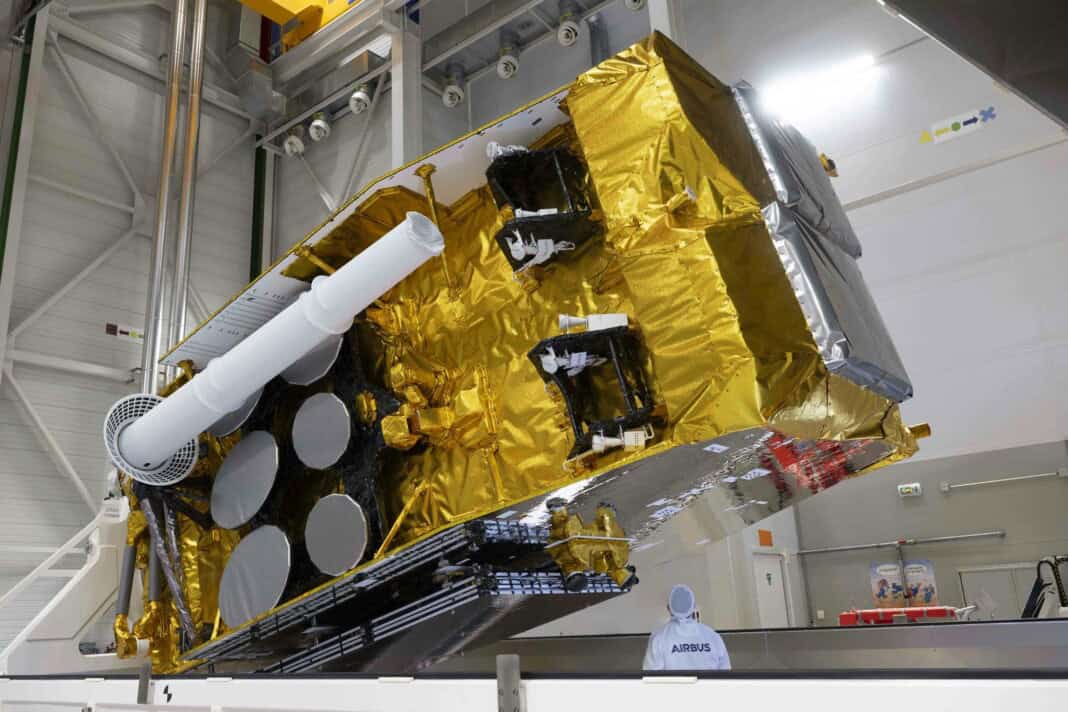This site is also available on:
Deutsch
Introduction to the SpainSat NG-II project
In a significant advance in satellite communications, SpainSat NG-II, the second new-generation secure communications satellite built by Airbus for Spain, was recently successfully launched from the Kennedy Space Center in the United States. This event marks a significant milestone for the country, as it concludes the ambitious SpainSat NG program – considered the most ambitious space project in Spain’s history and the most advanced government communications system in Europe. The program was significantly driven by the Spanish operator Hisdesat under the direction and sponsorship of the Ministry of Defense. The deployment of these satellites symbolizes a significant step forward in technological innovation and strategic communications for Spain and its allies.
The new generation of satellites is expected to enter joint service with the Spanish Armed Forces, international organizations such as the European Commission in the GOVSATCOM program, NATO, and other allied governments starting in spring 2026. This deployment is intended to ensure that Spain and Europe continue to have access to highly secure and reliable networks, which is extremely important given the increasing geopolitical challenges.
Technological innovations of SpainSat NG-II
SpainSat NG-II is based on Airbus’ Eurostar Neo platform and is approximately seven meters long and weighs around six tons. Its extensive technological innovations make the satellite a reflective example of state-of-the-art satellite-based communications technology. A key feature is its innovative payload system, which includes an active X-band antenna system for transmitting and receiving – comparable to the functionality of 16 conventional antennas. This enables exceptionally reliable and flexible communications, which is crucial for both military and government missions.
The antenna system can adjust its coverage up to 1,000 times per second, allowing it to respond to threats or requirements with high responsiveness. Furthermore, the system has the ability to precisely eliminate and locate jamming attempts, significantly increasing communications security. Given the increasingly complex threats in space, the active antennas are also hardened to provide protection, particularly against potential nuclear electromagnetic pulses, which could otherwise significantly impact satellite communications.
The entire payload, which makes up about half of the satellite, was developed and manufactured by the Spanish space industry under the leadership of Airbus, underlining the country’s high level of technological independence and expertise in the field of space technology.
Importance for security and strategic autonomy
The SpainSat NG-II project exemplifies the growing importance of secure satellite communications in numerous applications. These include not only military operations, but also humanitarian and rescue missions, where robust and interference-resistant communications channels are vital. With the implementation of this state-of-the-art system, Spain is positioning itself as a pioneer in Europe and one of the few countries worldwide with access to such advanced communications networks.
This capability secures Spain’s strategic autonomy and sovereignty, as well as that of its allies, since dependent or unsecured communications could pose significant risks in political and military contexts. Access to a reliable and flexible satellite-based communications system also enables real-time crisis response and control over communications infrastructures, which is invaluable in today’s geopolitically uncertain world.
The development and integration of active antennas was supported by international collaborations such as the Pacis 3 ESA-Hisdesat partnership and ESA ARTES programs, with significant funding from the Spanish Space Agency. This collaboration demonstrates the importance of multinational cooperation in promoting technological innovations that ultimately deliver security-relevant communications capabilities for multiple allies.
SpainSat NG-II: Future prospects and possible applications
With the launch of SpainSat NG-II, the technical foundation has been laid for a comprehensive, secure communications network intended for a variety of stakeholders and missions. These include the Spanish Armed Forces, international organizations such as the European Commission, which is involved in the GOVSATCOM program, as well as NATO and other friendly governments. The expected commissioning in spring 2026 is a significant step towards a connected, resilient, and sovereign communications infrastructure.
Spain will thus be able to rely on highly secure, flexible, and resilient satellite communications, whose innovative technology makes them robust even against interference and attacks. This capability is essential for information exchange in military operations and for supporting crisis response, where communication is often a matter of life and death. Furthermore, with this project, Spain is positioning itself as an important hub for the European security architecture in space.
This progress underscores the increasingly important role of space technology in national security and geopolitical strategy. The integration of such systems into multinational programs further highlights the need for close cooperation and harmonization among various actors to achieve common security goals.
Conclusion: Secure satellite communications for military and humanitarian missions
The successful launch of SpainSat NG-II represents an outstanding achievement for the Spanish space industry and completes the ambitious SpainSat NG program, considered one of the most advanced government communications systems in Europe. The combination of innovative technologies, such as the active X-band antenna system, and the ability to withstand jamming and electromagnetic interference, provides Spain and its allies with unparalleled secure and flexible communications capabilities.
Given the increasing importance of secure satellite communications for military and humanitarian missions, as well as strategic autonomy, the project represents an important contribution to the sustainability and resilience of the European security infrastructure. It demonstrates how technological innovation and international cooperation work together to meet modern requirements for sovereign communications in space.
Ultimately, SpainSat NG-II not only strengthens Spain’s capabilities but also its ability to cooperate with international partners, supporting political and military cooperation within Europe and beyond. These developments are groundbreaking for future projects in secure satellite communications and mark a significant advance in space and defense policy.
Overall, this project highlights the importance of leading technologies and strategic vision for tomorrow’s security and communications infrastructure, while positioning Spain as a key power in the field of satellite technology.




